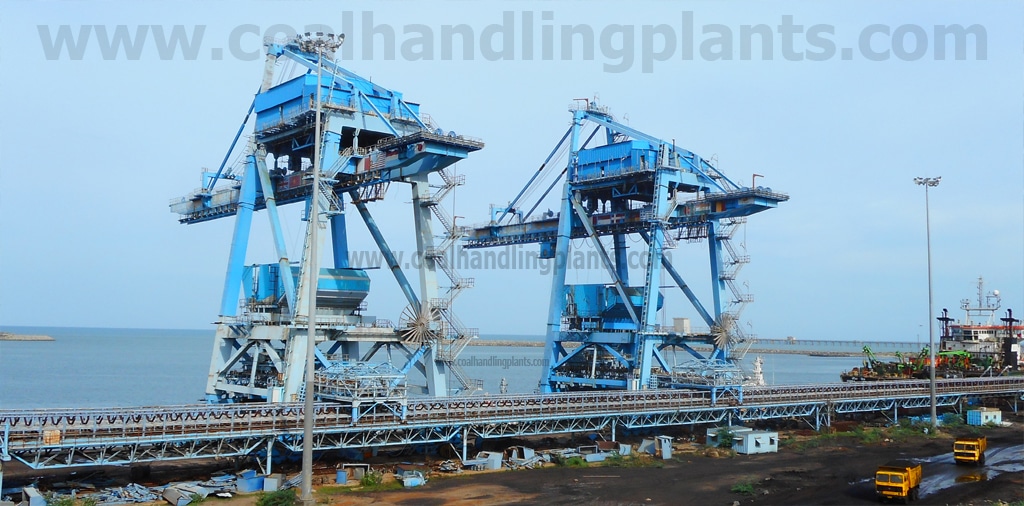The grab type ship unloader is a rail mounted clamp shell type grab bucket ship unloader. It exists in port constructed berths on CR rails with consisting of grab to unload the material(Coal,Iron ore etc.). It transfers the material from the ship to connected conveyor situated on the jetty through a hopper and a set of belt feeder & conveyor.

The ship unloader is composed of assemblies as listed below: –
-
Gantry Structure
It is the main skeleton of the machine which transfers all static and dynamic loads to the ground. Also, it gives support to all other accessories staircase and cable trays.
-
Staircase Assembly
It is access approach to the various floors in the gantry structure.
-
Maintenance Crane Assembly
An overhead crane is provided with its travel being on the overhead boom structure it will be capable of hoisting and moving the heaviest unit located in the machinery house with ease. The hoist will be electrically powered and can be controlled by the operator through the local pendant button control provided the machine system.
-
Machinery House
It is the room for all winch mechanism and transformer.
-
Central Lubrication
All the moving parts of the machine are to be lubricated in regular interval to maintain the life of moving parts. In this machine the following centralized lubrication system is envisaged.
- Gantry travelling and hopper lubrication.
- Lubrication in machinery house winches and boom sheaves.
- Manual lubrication points such as main trolley and auxiliary trolley wheels and other sheaves.
-
Boom Assembly
It is the luffing unit operated by boom winch unit. During non-operated time it shall be latched with the tower unit. It will give support to the trolley travel unit.
-
Main Girder Assembly
It is fixed part of support for trolley travel.
-
Trolley Assembly
The trolley run on rail section on the top and between the boom and girder with the trolley wheel and frame as an integrated unit. The rail shall be clamped and will be stiffened at transition and girder boom transition unit. The trolley will be driven by rope drum arrangement located in the machinery room. The structure shall be fabricated by rolled steel plates and shall be designed to support the hoist and trolley travel machinery and also sustain the effect of cycle loads to avoid fatigue failure.
The trolley shall be supported by four wheels connected by axis mounted on spherical roller bearings on both sides of each wheel. Two heavy duty guide rollers shall be fitted to each assembly on one rail.
-
Boom Close/Open Assembly
It comprises of winch, rope, sheaves and drive unit which gives luffing motion to the bottom steel structure.
-
Grab Hold/ Grab Close
It comprises of winch, rope, sheaves and drive unit which gives motion to the grab movement. The rope is connected with the grab bucket.
-
Sheaves Assembly
It gives support to the ropes for various winches operating mechanism.
-
Operator cabin Assembly
The operated cabin is fixed underneath the boom assembly and is moveable underneath the boom structure the cabin is made of transparent Perspex glass with a seat for the operator along with all controls to operate mounted on the seat.
-
Hopper Assembly
The hopper designed with an adequate opening for the charge from the grab with the inclined walls. When the permissible level is reached the movement of the open grab is locked by the operator on receipt of the signal avoiding spill of the charge. Load cell are provided underneath the hopper to monitor overload if any. The hopper walls are lined with linear plates to minimize wear. A pin rod gate is positioned under the hopper to control the flow of the discharge during maintenance.
-
Spill Plate Assembly
A movable spill plate is suited next to the hopper extending on the sea side of the grab unloader is operated by two cylinders through a hydraulic power pack is provided. It can be locked in its upper most position by limit switches. The spill plate prevents the coal dust falling from the grab onto the personal on the berth. The dust is emptied into the hopper by operating the hydraulic cylinders.
-
Belt feeder
The belt feeder is located below the hopper, which receives the material from the hopper and conveyed to the telescopic belt conveyor. The belt feeder is driven by electric motor VFD controlled. Tensioning is by manual take-up.
-
Telescopic Conveyor
The telescopic conveyor receives the material from the belt feeder. The telescopic conveyor is fixed with the belt weigh scale and moveable head end. The weigh scale continuously monitors the unloading rate. By operating VFD in the belt feeder we control the throughput capacity. The head end of the belt conveyor is fixed on the rack and pinion mounted frame, the pinion rotates forward and backward which moves the rack to the desired location of discharge position. The travelling length is controlled by the end limit switch.
-
Travelling House Assembly
Ship unloader travelling house assembly provided the shelter to the discharge of telescopic geared motors as well as discharge end. The house is moving on the jetty conveyor support structure rail.
-
Gantry Travel Arrangement
The ship unloader is mounted on a gantry with eighteen bogies. On each bogie there are two wheels present. The bogie is driven by a electric gear motor located on the seaside and land side one wheel on each bogie. The load from the gantry is equally transferred to the bogies through set of upper, intermediate and lower equalizer.
RELATED SEARCHES: